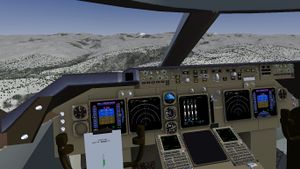Boeing 747-8i
 | |
|---|---|
 Splash screen | |
 The cockpit of the 747-8i | |
| Type | Airliner |
| Configuration | Wide-body aircraft, Double-deck aircraft, Low wing aircraft |
| Propulsion | Jet aircraft |
| Manufacturer | Boeing |
| Author(s) |
|
| FDM | YASim |
| --aircraft= |
747-8i 747-8f |
| Status | Beta |
| FDM |
|
| Systems |
|
| Cockpit |
|
| Model |
|
| Development | |
| Website |
|
| Repository |
|
| Download |
|
| License | GPLv2+ |
|
| |
The Boeing 747-8 is a wide-body jet airliner developed by Boeing Commercial Airplanes. Officially announced in 2005, the 747-8 is the fourth-generation Boeing 747 version, with lengthened fuselage, redesigned wings and improved efficiency. The 747-8 is the largest 747 version, the largest commercial aircraft built in the United States, and the longest passenger aircraft in the world.
Aircraft help
|
|
| Key | Function |
|---|---|
| Ctrl+b | Speedbrakes |
| Del | Reverse thrusters |
| B | Parking brake |
All buttons/switches in the cockpit can be controlled using the mouse. Most buttons exist of a toggle, where clicking it toggles it either on or off. Switches can be turned clockwise with the left mouse button and counter clockwise using the middle mouse button. Some buttons/switches have a cover on them, clicking it will either open or close it, so the button/switch can be pushed/turned.
Several panels are also available as 2D overlay panels. Clicking the hydraulics or electric overhead panels will open up a 2D variant. Useful when you'd like to keep an eye on the EICAS during startup! You can close the panel via Shift-P.
Important notice: as of FlightGear 2.6.0, the 744 has tiller steering, just like the real aircraft where the pedals only turn the nose wheel by a few degrees - to achieve optimal precision during takeoffs and landings. Use the tiller (747-400 > Tiller Steering) dialog to steer during taxiing.
- You can also connect a separate joystick axis to the tiller control - just like in the real aircraft, where there is a separate control wheel.
- Finally, you can also disable the separate tiller control and revert to the unrealistic behaviour of using pedals only to completely control the nose wheel (see 747-400 > Tiller Steering dialog).
Duo flight crew
Currently the pilot monitoring really cannot do anything else than monitoring. All switches and controls must be operated by the pilot flying.
- Pilot flying: launch the 747-400 as usual.
- Pilot monitoring: launch the 747-400-fo (First Officier) and position yourself somewhere close to the PF's positions. Now open the Boeing 747-400 > Select MP-pilot dialog and click the prefered PF's callsign.
Simplified procedures
Startup
- Press the continuous ignition switch on the overhead panel.
- Pull the start select switch for engine #4.
- Set the cutoff switch on the pedestal to RUN.
- Now repeat step 2 and 3 for engines #1, #2 and #3.
Takeoff
- Set flaps to 20, it will take a minute to extend, so you'd better do this during taxi.
- Smoothly apply full throttle.
- Push the stick slightly forward until atleast 80 kts.
- Around 160 kts, slowly pull the stick back to rotate. Rotate toward 15° pitch attitude.
- The plane should takeoff around 180 kts.
- Retract gear as soon as the aircraft is climbing with atleast 500 ft per minute.
Approach
- At 10000 ft MSL set the inboard landing light switches to ON.
Landing
- Set the flaps as directed by the flap extension schedule.
- At glideslope alive:
- Gear down.
- Set flaps to 20.
- At glideslope capture:
- Set flaps to 25 or 30.
Landing roll
- Close all thrust levers.
- Set speedbrakes to UP.
Shutdown
- Set all fuel cutoff switches to OFF.
- Turn continuous ignition OFF.
| |||||||||||